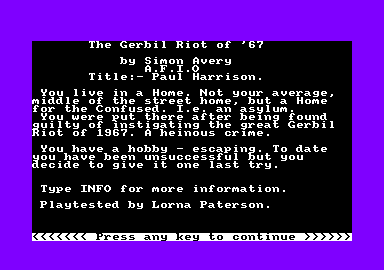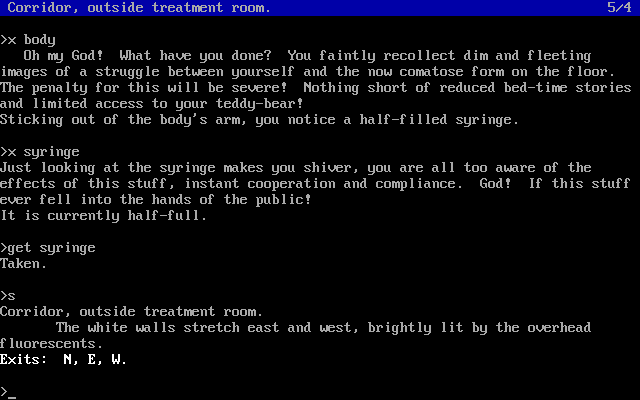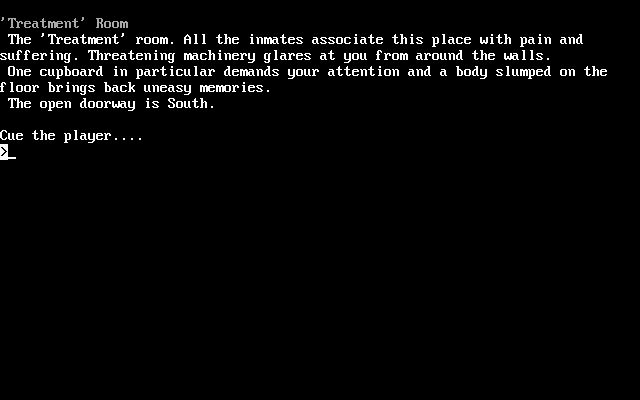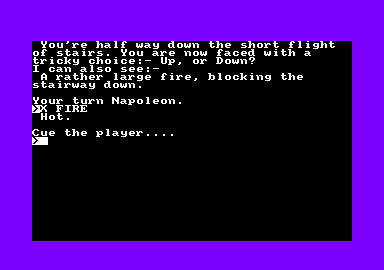Retro Replay Review
Gameplay
Gerbil Riot of ’67 takes the classic text‐adventure structure and injects a dose of surreal humor into every interaction. You begin as a reluctant patient in an asylum, presented with simple commands that evoke the spirit of early TRS-80 adventures. The parser is surprisingly forgiving, understanding both basic and compound commands, making it easy to experiment and avoid the frustration of precise phrase matching.
The core loop revolves around exploration and object combination: picking up seemingly mundane items, examining them closely, and figuring out which tools unlock new areas of the asylum’s winding corridors. Puzzles range from straightforward key‐and‐lock mechanics to more inventive tasks, like presenting a squeaky toy to a disgruntled squirrel who will only barter for a very specific nut configuration. These quirky challenges feel fresh, even if they sometimes hinge on lateral thinking that borders on whimsical absurdity.
Non‐playable characters (NPCs) in Gerbil Riot of ’67 each exhibit a single dominant trait: the garrulous guard who won’t stop reciting nonsense rhymes, the shy orderly fixing broken valves, and the enigmatic squirrel with its own peculiar demands. Interaction with each character yields clues or items essential for escape, and the charm of these one‐note personalities maintains engagement throughout the game.
Despite its roots in text adventures, the pacing here is deliberate. You must piece together clues, backtrack through familiar hallways, and revisit previous scenes as new items become available. This measured discovery process rewards patient players who enjoy the satisfaction of making incremental progress rather than being rushed through a linear storyline.
Graphics
Though Gerbil Riot of ’67 is primarily a text‐based experience, the minimalistic ASCII art title screens and transition animations set a playful tone from the outset. Simple line drawings depict the asylum’s creaky doors, barred windows, and occasional petulant gerbils scurrying past. This stripped‐down visual style hearkens back to early personal‐computer adventures, evoking nostalgia without feeling outdated.
The choice of typography and color scheme plays a surprisingly big role in readability and atmosphere. Contrasting text on a muted background reduces eye strain during marathon puzzle sessions, while judicious use of colored text highlights important items, character names, or environmental hazards. It’s a subtle flourish that keeps you oriented without detracting from the story.
Spatial mapping is aided by a simple overhead schematic available on request, allowing you to sketch your own notes or rely on the built‐in navigator. While it lacks the graphical fidelity of modern adventure titles, this bare‐bones approach enhances immersion: you truly feel like you’re navigating darkened corridors by the light of your wits alone.
Small sound cues—like the rattle of chains or the squirrel’s frantic chitter—occasionally punctuate the silence, adding an extra sensory layer without overwhelming the text. These brief audio touches work best when you’re immersed in the narrative, heightening tension or humor just when you need it most.
Story
At its heart, Gerbil Riot of ’67 is a whimsical escape tale with an offbeat twist: the riot of the title never actually occurs within the asylum’s walls, but it looms large in backstory and rumor. You play an inmate who’s decided that the outside world, chaotic as it may be, is infinitely preferable to life behind these locked doors. Every corridor hides both potential freedom and deeper madness.
The narrative unfolds in fragments, revealed by overheard dialogues, hastily scrawled notes on walls, and the bizarre requests of fellow inmates and staff. Characters share snippets about the rumored gerbil uprising in the city streets, and while you never directly participate in that event, it serves as a clever metaphor for breaking free from mental constraints.
Humor is woven throughout, from puns carved into cell doors to the laughably single‐minded hamster technician who insists on fixing leaky pipes at all costs. Even in moments of tension—when a critical item is just out of reach or a locked cell door taunts you—the game’s playful tone prevents the experience from becoming too grim.
By combining a simple escape objective with richly idiosyncratic NPCs and an offstage wildlife rebellion, the story sustains curiosity. You’re never quite sure which interaction will unlock the next plot beat, so the urge to type “EXAMINE GUARD” or “TALK TO SQUIRREL” keeps you clicking away long into the night.
Overall Experience
Gerbil Riot of ’67 offers a delightful throwback for fans of classic text adventures, while its quirky characters and inventive puzzles make it accessible to newcomers. The game balances nostalgia with modern conveniences—like forgiving parsers and navigational aids—so you spend more time imagining scenarios than troubleshooting command syntax.
The engagement factor is high: each corridor you map and every peculiar item you combine delivers a small gratification. If you enjoy unraveling mysteries at a leisurely pace and delight in offbeat humor, this asylum escape will hold your attention from start to finish. The occasional head-scratching puzzle can be challenging, but never feels unfair.
While its graphics and sound are deliberately understated, the writing carries the full weight of world‐building. Character quirks and environmental descriptions paint a vivid mental picture, proving that compelling narrative can thrive even without high‐end visuals or voice acting.
Ultimately, Gerbil Riot of ’67 is a testament to the enduring appeal of text adventures. Its whimsical storyline, inventive puzzles, and memorable cast make it a standout choice for anyone seeking a charming and mentally stimulating escape. Prepare to challenge your brain, crack a smile, and lose yourself in the delightful madness of this peculiar asylum romp.
 Retro Replay Retro Replay gaming reviews, news, emulation, geek stuff and more!
Retro Replay Retro Replay gaming reviews, news, emulation, geek stuff and more!








Reviews
There are no reviews yet.